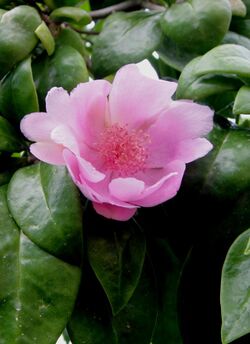Biology:Leuenbergeria quisqueyana
| Leuenbergeria quisqueyana | |
|---|---|

| |
| Scientific classification | |
| Kingdom: | Plantae |
| Clade: | Tracheophytes |
| Clade: | Angiosperms |
| Clade: | Eudicots |
| Order: | Caryophyllales |
| Family: | Cactaceae |
| Genus: | Leuenbergeria |
| Species: | L. quisqueyana
|
| Binomial name | |
| Leuenbergeria quisqueyana (Alain) Lodé
| |
| Synonyms | |
| |
Leuenbergeria quisqueyana, known as the Bayahibe rose,[2] is a species of cactus that is endemic to the Caribbean island of Hispaniola, in the Dominican Republic.[3]
Taxonomy
The species was discovered by the France botanist Henri Alain Liogier in 1977 as Pereskia quisqueyana, the description being published in 1980. He named it quisqueyana, in honor of the Dominican Republic, which is also referred to natively as Quisqueya.[4]
Description
Leuenbergeria quisqueyana[5] is a dioecious cactus that resembles a shrub and reaches up to 6 metres (20 ft) in height. Its trunk is surrounded by groups of spines which erupt in bunches. Its succulent leaves are elliptical in shape and are a bright green color. The flower of L. quisqueyana is pink in color and blooms from the ends of its branches. Its fruits are yellow and contain black seeds.
Distribution and habitat
L. quisqueyana is one of only several cactus species which possess leaves. Its natural habitat includes Hispaniolan dry forests that are found on the southeastern coast of Hispaniola, particularly around the town of Bayahibe, its namesake. It is critically endangered due to habitat loss.[6]
National symbol
Law 146-11 of the Dominican Republic established the Bayahibe rose as the national flower of the country and ensured its protection due to its endangered status.[7]
References
- ↑ Gann, G.D.; Griffith, P. (2013). "Pereskia quisqueyana". IUCN Red List of Threatened Species 2013: e.T151927A577173. doi:10.2305/IUCN.UK.2013-1.RLTS.T151927A577173.en. https://www.iucnredlist.org/species/151927/577173. Retrieved 13 August 2020.
- ↑ "Bayhaibe Rose" (in en). https://www.bayahibevillage.com/bayhaibe-rose.
- ↑ PUCMM. "Pereskia Quisqueyana" (in es). http://rsta.pucmm.edu.do/ciencias/arboretum/intro/website%20sub%20pages/Arboretum/area_2/pereskias/1-pereskias/body_1-pereskias.html.
- ↑ "Flores en Casa de Campo # 9: Rosa de Bayahibe" (in Spanish). Casa de Campo Living. https://casadecampoliving.com/es/flores-en-casa-de-campo-9-rosa-de-bayahibe/.
- ↑ "Pereskia y Leuenbergeria" (in Spanish). José E. Marcano M.. https://ecohis.jmarcano.com/biodiversidad/pereskia/.
- ↑ "Leuenbergeria quisqueyana (Alain) Lodé". Encyclopedia of living forms. 2012-12-28. https://llifle.com/Encyclopedia/TREES/Family/Cactaceae/32841/Leuenbergeria_quisqueyana.
- ↑ Govierno de la República Dominicana (2011). "Ley No. 146-11 que designa al árbol de la caoba como Árbol Nacional y la rosa de Bayahíbe como Flor Nacional de la República Dominicana" (in Spanish). https://bvearmb.do/handle/123456789/288.
Wikidata ☰ {{{from}}} entry
 |


